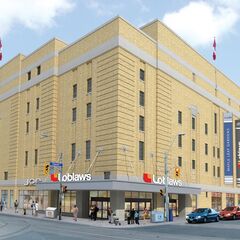Maple Leaf Gardens' hockey heritage shouldn't face elimination (Star)
Gardens' hockey heritage shouldn't face elimination
JIM COYLE
That old colour commentator Hesiod was, so far as history records, no hockey expert.
But he did know enough about life in general to have held his own with any of your modern-day analysts on the sports channels.
"Right timing is in all things the most important factor," Hesiod apparently quipped on some between-periods panel in the 8th century or so B.C.
And ain't that the truth.
It doesn't take an ancient Greek to suspect it's a master stroke of ill timing for a public forum on the future of Maple Leaf Gardens to be commencing at the St. Lawrence Centre for the Arts tomorrow night at about the very time the shinny sides from Toronto and Ottawa are nicely under way in Game 4 of their NHL preliminary playoff round.
If the Gardens is all but ignored nowadays while it falls ever further into decrepitude, it's hardly apt to be the cause of much attention from hockey fans when all eyes are focused on proceedings at the Corel Centre in suburban Ottawa.
Still, if the St. Lawrence event is unlikely to be a gold mine for scalpers, it is a worthwhile cause nonetheless for this city and those who care about its past.
From architects such as Jack Diamond to former Leaf star and current Senator Frank Mahovlich, who are among speakers at the forum, the Friends of Maple Leaf Gardens will be renewing efforts to safeguard the fabled building against the various sacrileges proposed for it and to ensure any future use is "appropriate to its cultural and social importance."
Maybe those who say the Gardens has no future in Toronto will be proved just as wrong as critics were almost three-quarters of a century ago who said the idea for it would never fly, that it couldn't be financed, couldn't be built on schedule, and if it was couldn't be filled.
There's actually a story from the days before the landmark arena was built that might interest the Friends of Maple Leaf Gardens and encourage their efforts to keep the building's fate in the public eye.
Back in 1930, legendary warrior-entrepreneur Conn Smythe and soldier-turned-storyteller Greg Clark were apparently on the road together with the Leafs in Montreal. Smythe owned the team, Clark was covering them for the Star, and the two were part of a group killing time in a hotel prior to a game against the Maroons.
As Smythe would recall it in his memoirs, he was beating the drums for his favourite topic — that his team needed a bigger, better rink to play in than the old arena down on Mutual Street, which held only 8,000 fans, 9,000 if you counted standees.
"As a place to go all dressed up, we don't compete with the comfort of theatres and other places where people can spend their money. ... We need at least 12,000 seats, everything new and clean, a place that people can be proud to take their wives or girlfriends to."
What he wanted was "a temple dedicated to the game."
Clark got so excited, Smythe said, that he bounded onto the back of a chair, then a table, then a bed, telling the assembled that "we had to do it, we had to get people convinced that we needed a new arena.
"Somebody else there, I think a car salesman, said we had to come up with a slogan. `That's the way you get things done today — get them saying: We have to have a new arena! We have to have a new arena!'"
The rest, as they say, is history.
Against all odds, in the teeth of a Depression, in a mere 155 days from the time shovels went in the ground, Maple Leaf Gardens was built.
Almost from the beginning, it was everything its builder and his backers dreamed it would be — an instant financial success, the hottest ticket in town, and soon almost as well-known a national symbol as Niagara Falls and the Parliament buildings.
So iconic was its status, it would have been hard for earlier generations to imagine that a public meeting would one day be held in Toronto to discuss its future, hard to imagine the shrine would have sat vacant for five years, hard to believe it would have been considered for such uses as a supermarket, a home improvement store, or condominiums.
The Gardens, to be sure, grew shabby over decades, and with the eventual revelation of some of the abuses that went on therein, its glory was tainted.
But it was for generations a symbol of national identity in a young country that didn't have many.
And as author John Bentley Mays has said, in his book Emerald City, whatever its modest architectural merits, "When you're talking about the Lourdes of hockey, it's the miracle of winning in overtime that matters to those millions of Canadians glued to their TV sets, not whether the Art Deco styling in the brickwork over the marquee is up to snuff.
"The Gardens must never go, so long as there are people alive who remember it in its most happy moments."
Now, historic designations having been won, the challenge is not so much that it doesn't go but that its place in the country's life and history be respected and preserved.
Good luck to the Friends of MLG. (Though, as Hesiod might have said, better luck next time with the scheduling.)







